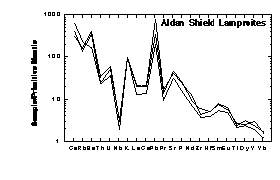
Ultrapotassic magmatism was widely developed in the northern and central Aldan Shield region of Siberia during the Mesozoic, and occurs in a northeast-southwest belt approximately 500km long by 150km wide. Lamproitic sills, dykes and pipes range in age from 143 to 122 Ma. The lamproites have primitive compositions with generally high Mg-values (57-86), and high Cr (110-1515 ppm) and Ni (90-700 ppm) concentrations, which in some cases are partly due to olivine accumulation resulting from flow segregation. The lamproites have high K2O/Na2O with K2O contents up to 8.3 wt.%, coupled with high Rb, Sr and Ba, but substantially lower TiO2 (<1.4 wt.%) than other documented lamproite occurrences. They also have low Ti/Eu, Nb/U, Th/U, Ce/Pb, and low Zr and Nb concentrations coupled with relatively high Zr/Nb and La/Nb. This results in a marked relative depletion of HFSE and enrichment of Pb in primitive mantle-normalised diagrams (Fig. 1).
Nd and Sr isotopic ratios are relatively unradiogenic with low eNd values (-10.2 to -21.8) and comparatively low 87Sr/86Sr values (0.70564 to 0.70790) which are very similar to lamproites from Smoky Butte, and substantially less radiogenic than examples from Western Australia and southern Spain. Pb isotope ratios are also relatively unradiogenic (206Pb/204Pb = 16.608 to 17.420, 207Pb/204Pb = 15.243 to 15.474, 208Pb/204Pb = 37.126 to 37.497), and the data fall to the left of the Geochron in a 206Pb/204Pb versus 207Pb/204Pb diagram. The isotopic data suggest the mantle source for
the Aldan lamproites was characterised by long-term low Rb/Sr, Sm/Nd and U/Pb values with depleted mantle Nd model ages of 1.81 to 2.66 Ga. The Pb isotope data can also be modelled assuming a mantle source initially with µ ~ 8.9 until approximately 2.5 Ga BP, followed by a relatively
low µ stage (µ ~ 6.3) until the time of extraction from the lithospheric mantle in the Mesozoic.
The minor and trace element characteristics of the Aldan lamproites differ from most other lamproite occurrences in their lower concentrations of HFSE and LREE. When coupled with their relatively refractory major element (low TiO2 CaO and Al2O3) and mineralogical (olivine mg = 90 to 94.6) compositions these features suggest that they were derived from a depleted mantle source that experienced a subsequent enrichment in LILE (K, Rb, Sr, Ba, Pb and U) and , to a lesser extent, LREE with negligible enrichment in the HFSE (Ti, Zr, Nb, Hf and Ta). This style of enrichment is most like that inferred for the sources of modern subduction zone volcanism. However, the unradiogenic Pb isotope compositions suggest that this was an ancient subduction-related enrichment event rather than a product of the convergence and accretion of mobile belts to the Aldan Shield during the Mesozoic. The absence of significant HFSE enrichment associated with the LILE enrichment suggests that source modification was caused by a fluid rather than involving hybridism of the depleted mantle by silicic melts derived from the subducting slab or associated sediment as has been suggested for ultrapotassic volcanics from modern island arc settings. This is supported by the chondritic Nb/Ta values (~ 17) for the Aldan lamproites, whereas source modification involving siliceous slab-derived melts appears to result in a significant increase in Nb/Ta values (up to 33).
Lamproitic magmatism in the Aldan Shield was most likely initiated by limited extension and subsequent partial melting within the deep lithospheric mantle in response to Mesozoic subduction-related collisional events.
Fig. 1: Primitive mantle-normalised diagram for representative Aldan Shield lamproites.